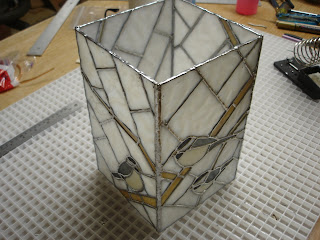
This is a chunk of figured Western Walnut. Eventually, it will be the base for the lamp.I picked this up from the scrap bin of a local gun stock blank sawyer.
In its raw form, it is about 30" long x 3" high x 2.5" wide. I need to make a box that is 6" wide x 6" high x 3/4" thick. So I'm going to resaw this board and glue it together to make a bookmatch.

I used my table saw to cut it apart. You can see the burn marks from the blade. I would rather have used a bandsaw for this operation. The bandsaw would have made a cleaner cut and its thin blade would not have wasted so much material. Unfortunately, I do not have a bandsaw.
After I scraped away the dried glue I ran the board through my thickness planer until it was the proper thickness. I am going for a thickness of 3/4".

I need a useable 24" of length that is at least 6" wide. This board barely gave those dimensions to me. Close enough! Here you can see the figure of the walnut. This is raw wood. When I add the finish, the figure should really POP!

I have now cut the board down to its final dimensions and cut the miters. Each board is 6" long, but only 5" high. I cut off some extra height in order to made the colors and figure of the board look more balanced. Next, I will cut grooves into the inside face of the boards. One groove will hold a plywood bottom. The other groove will hold the lamp.

Here is the plywood bottom. It is 3/4" baltic birch plywood. Now, you may be asking me, "Isn't 3/4" plywood a bit thick for a simple project like a lamp?". To that I would say, "Yes". But do you see that hole in the middle of the board? That is the hole that holds the lamp socket. For the lamp socket to properly seat and then stay put, a thick board is necessary. I did cut a rabbet around the edges of the plywood so that I could keep the groove in the walnut base to a minimum. The groove is 1/4" wide and 1/4" deep.

Here you can see all of the grooves and the plywood bottom ready for glue-up. I've already sanded each piece with 150 and 220 grit sandpaper.

Gluing up a mitered box is easier to do with masking tape than regular wood clamps. Here you can look into the top of the box where the groove will hold the brass base of the lamp. The groove is 1/4" wide and approx. 1-1/2" deep.

OOPS! I decided that the wood base needed "feet". So I set up my router table and proceeded to remove the wood I no longer wanted. My mistake was feeding the wood into the router bit to aggressively. I ended up splintering the wood on two of the feet. Of course, the splinters (they were chunks!) were long gone when I realized what I had done. So there was no hope of just gluing the broken pieces back in place. The pieces that broke off left a void that was approx. 1/4" wide x 1/4" long x 1/16" deep. I had to fill the void with something.
A crusty old woodworker friend of mine taught me this trick. First, get some fine sawdust from a scrap of the project (walnut in this case). My random-orbit sander had some in the dust catcher. Pile up a small mound of saw dust and add cyanoacrylate glue (super-glue) and mix together until it forms a paste. Your going for the consistency of peanut butter. But don't sweat it too much, just make sure you can spread it. Get a scrap of wood and spread the brown mixture directly into the void. Make sure to use more than you need. And don't worry about perfect application. You will be able to sand away the excess after it dries.

A splotchy looking repair. Ready for final sanding!

Here is the box right after the first coat of Danish oil. I started with medium walnut color to hopefully bring out the figured grain. (I think it looks pretty sharp right now!) Later coats were tung oil. After it was completely dry, I gave it a final sanding with 600 grit wet-dry paper and rubbed on a coat of furniture wax.

And here it is! This was a really challenging project! But the result was worth it and I can't wait to start my next version of this fantastic lamp.












































